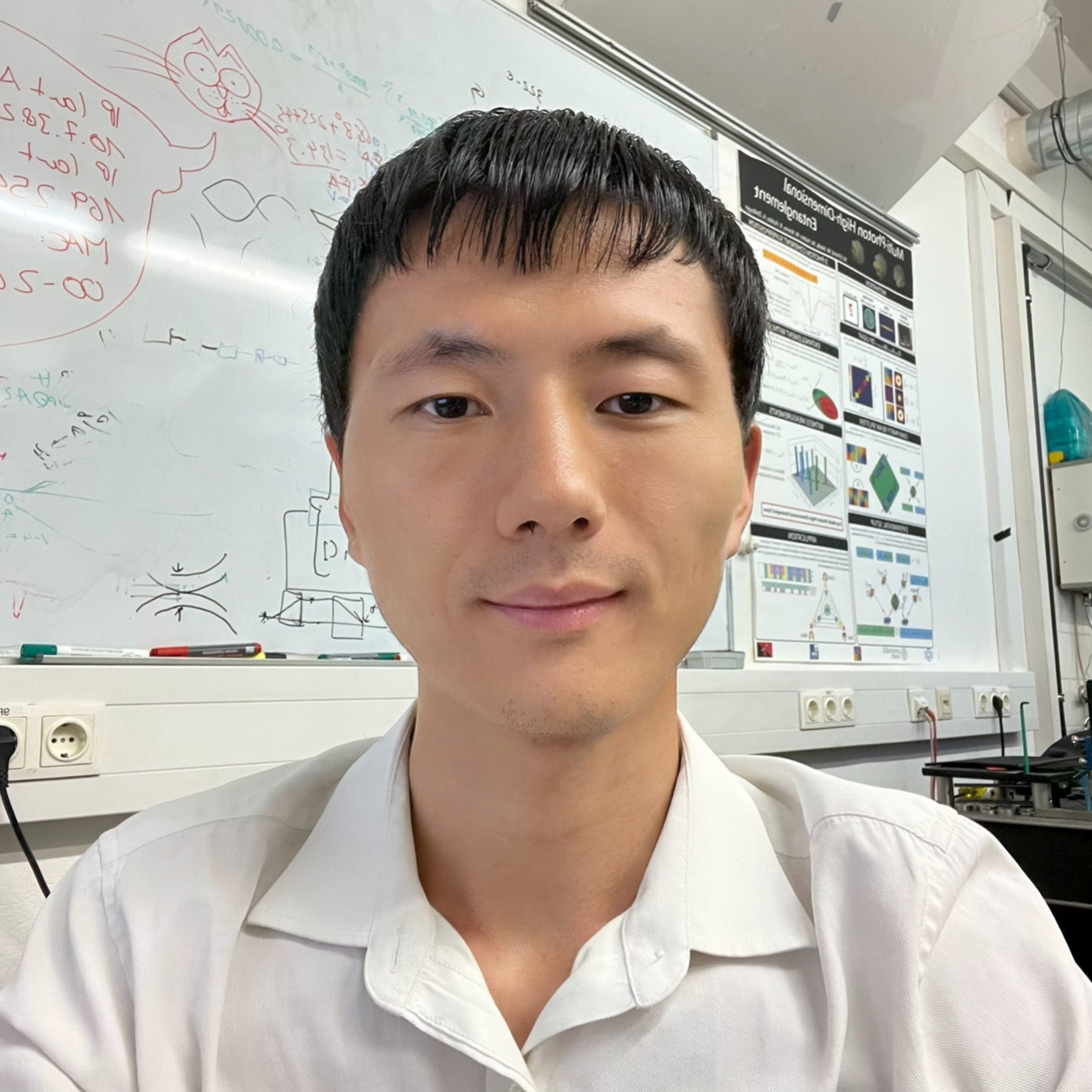
Xinhe Jiang, Dr.
Quantum optics, Quantum foundations, Quantum information processing
Education
- 09/2011 — 07/2016 – Ph.D., Condensed Matter and Material Physics, School of Physics, Peking University, Beijing, China
- 08/2007 — 07/2011 – B.Sc., Optical Information Science and Technology, Department of Physics, Harbin Institute of Technology, Harbin, Heilongjiang, China
Research Experience
- 02/2021 — Present – Professor Anton Zeilinger’s Group, Austrian Academy of Sciences, Austria
- Research on quantum contextuality and Bell inequality. Quantum state generation and entanglement characterization, exploring the connection between contextuality and nonlocality using qutrit source.
- Nonlinear crystal interference using path identity. Exploring the interpretation of path information in nonlinear interferometers.
- 08/2016 — 09/2020 – Professor Xiao-Song Ma’s Group, Nanjing University, China
- Research on applying surface plasmon polaritons to quantum optics experiments. Realizing Quantum Teleportation Mediated by Surface Plasmon Polaritons.
- Quantum state verification: Using a polarization-entangled source to generate a two-photon entangled state and verify the quantum state using an optimal verification strategy.
- Numerical calculations on the quantum random walk of one photon, two photons and entangled photons. Theoretical study on the hidden variable models, Bell inequality, quantum correlations, no-signalling correlations, quantum non-locality and superluminal influences of the v-casual models.
- Quantum memory: theoretical calculation on the coupling of a two-level system and a photon.
- 09/2011 — 07/2016 – Professor Jun-Jie Shi’s Group, Peking University, China
- Device Applications of Full Composition and Adjustable III-nitride Semiconductor Photoelectric Functional Materials Research on the Microscopic Mechanism of the Luminescence of Defect-dominated GaN and AlN Nanowires.
- Carry out the DFT modelling and calculate the electronic structures and optical properties of semiconductors by means of first-principles computational software, such as VASP, CASTEP, etc.
- 09/2013 — 06/2014 – Professor Jing Lu’s Group, Peking University, China
- Conducted research on the electronic structures and surface properties of 2D materials.
- Calculate the electronic, optical and magnetic properties of Graphene and Silicene after adsorbing some metal atoms (Cu, Ag, Au, Ni, Zn, etc.) on them.
- Programming to separate the band structures of the C, Si atoms and the metal atoms. Using Fortran and Shell Script to process the data and export for plotting.
- 09/2010 — 06/2011 – Professor Shu-Tian Liu’s Group, Harbin Institute of Technology, China
- Research on the interference and correlation of photon orbital angular momentum freedom based on the technique of Spontaneous Parametric Down-Conversion (SPDC) (Undergraduates’ Graduation Project of HIT).
- Construct the theoretical model for the density matrix. Using MATLAB to perform numerical calculations and analysis of the influence of the aperture separation and opening angle on the detection probability and entanglement measure.
Presentations
- Poster presentation. Xinhe Jiang, Armin Hochrainer, Jaroslav Kysela, Manuel Erhard, Xuemei Gu, Ya Yu, Anton Zeilinger, “Subjective nature of path information in quantum mechanics”. Helgoland 2025 – 100 Years of Quantum Mechanics. Hamburg, Helgoland, June 9-14, 2025.
- Oral presentation, Conference Abstract. The 3rd JiangSu Physical Society Spring Meeting-Section J: Quantum computation and quantum communication. Yangzhou, Jiangsu, May 10-12, 2019.
- Poster and Oral presentation. Xinhe Jiang, Kaiyi Qian, Peng Chen, Zhaozhong Chen, Xiaosong Ma, “Quantum teleportation of surface plasmon polariton”. Nature Conference on Nanophotonics and Integrated Photonics 2018, Nanjing, November 9-11, 2018. Best Poster Award – Second Place.
- Poster presentation. Xinhe Jiang, Kaiyi Qian, Peng Chen, Xiaosong Ma, “Quantum teleportation of surface plasmon polariton”. The second Integrated Light Quantum Information Technology Youth Academic Forum. Nanjing, December 1, 2018.
- Oral presentation. Chair “The LUM – China Academic Network 2018-Satellite workshop on quantum optics and quantum information”. Nanjing, November 23, 2018.
Patents
- Invention Patent, “A standardized method of quantum state verification based on optimal strategy”; Inventors: Xiaosong Ma, Xinhe Jiang, Kun Wang, Kaiyi Qian, Liangliang Lu; Authorization number: CN111460421B; Authorization date: 21 July 2023; Patentee: Nanjing University.
Skills
- Expertise: Optical system design and build. Generation and detection of single and entangled photons. Automation control of electronic devices using LabVIEW and electric optic modulator (EOM). Time-tagged photon counting with coincidence logic.
- Languages: Strong reading, writing, and good speaking skills for English. Basic German reading and speaking.
- Coding: LabVIEW, Python, MATLAB, Mathematica, Julia, LaTeX, FDTD simulation …
- Others: Academic research, writing and publishing.
Projects
- Participant, “Quantum, quasi-quantum effect and functional integrated photonic chip in artificial microstructure”, No. 2017YFA0303704, National Key Research and Development Program, China.
- Participant, “The evolution of photon states in space-time and the related applications”, No. 1169030010, National Natural Science Foundation Program, China.
- Participant, “Foundations of optical quantum information and quantum physics”, Natural Science Foundation of Jiangsu Province, No. BK20170010, China.
- Participant, “Applications of high-dimensional photonic quantum states in quantum computation, quantum simulation and quantum communication”, NSFC-BRICS, No. 61961146001, China and BRICS.
- Participant, “All-solid-state quantum repeaters”, The Fundamental Research Funds for the Central Universities, China.